… and I am confident that all Steemians could follow and get something out of it!
With this first post on particle physics, I will explain in some details what modern particle physics is about, as promised in my introduction. I will describe the basics of our field and define in a simple way the fancy beasts that are described by our Standard Model.
This post is based on lectures that I have given to CERN summer students from 2013 to 2015, i.e., to people that are interested by our field but who do not necessarily master all the physics background (like probably most of the people who will read this post).
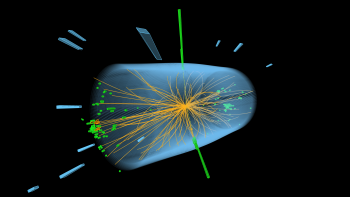 [image credit: Thomas McCauley]
[image credit: Thomas McCauley]
The table of content of this (very long) post is as follows:
- Physics? Why physics? And what is particle physics?
- Elementary? From the molecules to the electrons.
- Inside the atomic nucleus: the quarks
- Adding neutrinos
- Multiplying everything by three
- The three fundamental forces and the one which one does not care about
- The Higgs boson
- Summary
PHYSICS? WHY PHYSICS? AND WHAT IS PARTICLE PHYSICS?
The (very ambitious) goal of physics is to provide a description of all phenomena that are observed, starting from a small number of fundamental principles. More specifically the same laws should allow for explaining both microscopic and macroscopic effects.
However, sometimes, it is better not to try to kill a fly with a rocket launcher! Why should we study the motion of a car by considering the ensemble of gazillions of particles it is made off, including special relativity effects? Maybe to make Einstein happy but this is not a good reason. It is way better to take the right limit of the theory right away and consider classical physics or solid state mechanics.
And this way of taking the appropriate limits is what connects the different scientific fields.
For what concerns particle physics, one aims to describe the laws and the properties of the world of the elementary particles.
 [image credit: The Particle Adventure]
[image credit: The Particle Adventure]
We have a theory that does it. This theory is called the Standard Model and it describes almost all data so far with an extremely good precision (I will come back to the almost in my next posts).
The Standard Model is a theory in the sense that it consists of a mathematical structure that precisely explains most of the experimental facts of a specific research field. This scientific definition differs from the everyday-life meaning of the word theory that can be seen as an attempt for explaining some observed events.
ELEMENTARY? FROM THE MOLECULES TO THE ELECTRONS
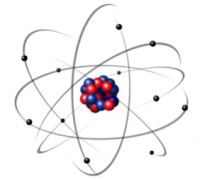 [image credit unknown (everywhere on the web)]
[image credit unknown (everywhere on the web)]
The Standard Model describe the elementary particles. But what are they?
I guess that everybody knows that matter is made of molecules that are made of atoms (and of a lot of empty space).
Those are still too big for us, and we need to go deeper inside. As can be seen on the image above, an atom is made of a core, the nucleus (the same guy that gives its name to nuclear energy), a lot of empty space (again; matter is mostly empty) and some peripheral electrons (the black dots on the picture).
These electrons are elementary particles and thus covered by the Standard Model. The nucleus is not. Still too big for particle physics.
INSIDE THE ATOMIC NUCLEUS: THE QUARKS
Let us continue our trip into the infinitely small.
A nucleus is made of neutrons and protons (the blue and red balls on the image above). Although these guys are important (after all, the Large Hadron Collider is colliding protons), they are still not elementary particles.
They are made of smaller entities called up quarks and down quarks.
Although this simplifies the picture, the reality is much more complicated: protons and neutrons (especially when accelerated) are dynamical objets made of many interacting quarks and gluons (the particles mediating the strong interactions).
But let us forget about this for this post so that one can avoid complicated details.
We will assume that protons are made of two up quarks and one down quark, and neutrons of two down quarks and one up quark, as shown on the image below.
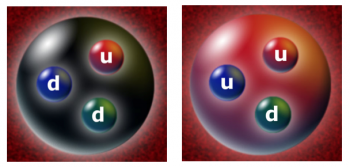 [image credit unknown (everywhere on the web)]
[image credit unknown (everywhere on the web)]
ADDING NEUTRINOS
The story of the elementary particles does not end here.
We have a fourth guy, the electronic neutrino, whose existence has been assumed to explain beta decay data. The beta decay is the mechanism (illustrated below) allowing a neutron to decay into a lighter proton and an electron.
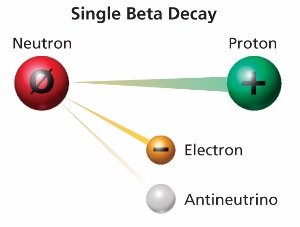 [image credit: Discover Magazine]
[image credit: Discover Magazine]
Without the neutrino, the energy of the electron is fixed by energy and momentum conservation. This contradicts data, as the energy spectrum of the electron is not a delta (where the energy must be a single value and nothing else) but a continuous spectrum.
In order to explain the observations, one must include a third final state product, the neutrino, that is invisible but allows for the electron to get an energy spectrum in agreement with data.
MULTIPLYING EVERYTHING BY THREE
The four elementary building blocks could be sufficient… but nature is nasty. Let us multiply everything by three, as shown on the picture below. The only difference between two copies is the mass: the first family is lighter than the second that is lighter than the third.
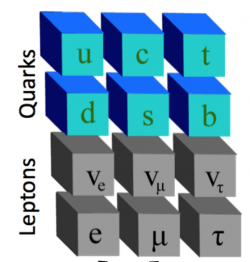 [image credit unknown (everywhere on the web)]
[image credit unknown (everywhere on the web)]
Why three? Well, if you know, please write a paper, get some credits and become a very well known researcher in particle physics.
So far, we just know there are three families of particles, and if there is a fourth one, it must have different properties from the three others (data tells us this).
We have hence a bunch of particles with funny names and that can be also found as plushes:
- three up-type quarks: the up (u), the charm (c) and the top (t);
- three down-type quarks: the down (d), the strange (s) and the bottom (b);
- three charged leptons: the electron (e), the muon (mu) and the tau (tau);
- three neutrinos: the electronic, muonic and tau neutrinos (nu).
THE THREE FUNDAMENTAL FORCES AND THE ONE WHICH ONE DOES NOT CARE ABOUT
The Standard Model of particle physics describe the elementary particles and their interactions. We have four fundamental forces in nature: gravity, electromagnetism, the weak interaction and the strong interaction.
In our description based on symmetries (which I will not talk about too deeply), one interaction between two particles can be seen as the exchange of one mediator, and we have one or more than one mediator for each type of interaction.
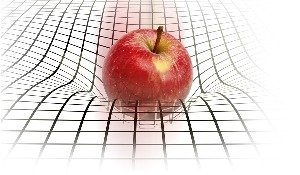 [image credit: Discover Magazine]
[image credit: Discover Magazine]
First, we will ignore gravity. This force is proportional to the mass of the involved guys, so that it is negligible at the fundamental level (the masses are tiny). Gravitational effects however become important with the energy (Einstein: mass is energy) but we are talking about energy domains way outside what can be built by humans.
In addition, we do not know how to treat it using our usual symmetry principles (if you know, please write a publication and try to get a Nobel prize).


 [image credits: Science Kids, Fermilab, Nobel Prize]
[image credits: Science Kids, Fermilab, Nobel Prize]
The three other interactions can be described by so-called gauge theories and in very short and very crude associate mediators to each interactions. The electromagnetism mediator is the massless photons, the weak interaction mediators are the massive W-boson and Z-boson and the strong interaction mediator is the massless gluon.
THE HIGGS BOSON
The story is almost done. We are missing one piece. All the construction of the Standard Model is based on symmetries. And those symmetries predict all particles to be massless. This is of course not the case. However, those symmetries also yield predictions in very good agreement with data. Therefore, they cannot be too wrong.
The idea proposed by Brout, Englert and Higgs was to break the symmetry spontaneously. This mechanism allows one to introduce the masses without sending the theory to the bin. The price to pay is one extra particle: the Higgs boson, that was discovered in July 2012.
SUMMARY
The summary of the Standard Model is shown in the picture below:
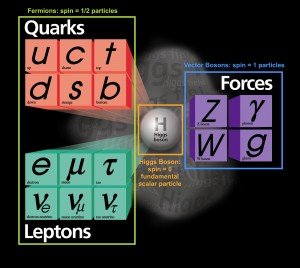 [image credits: Fermilab ]
[image credits: Fermilab ]
